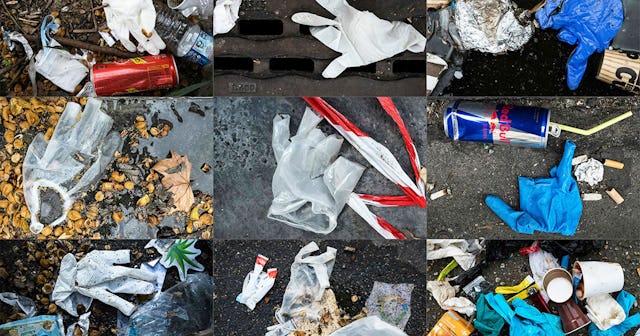The Pandemic Has Produced A New Kind Of Litter Problem

My birthday is on April 22nd, which is also Earth Day. The only I gift I ask from my kids is that we go on a trash walk. Despite moans and initial reluctance from them, we grab a few trash bags and the wagon then head out for about an hour to pick up trash around our surrounding neighborhoods. While trash is dirty, I don’t get too worked up about gross stuff and my kids don’t either. Unless it’s super gross, the kids and I pick up discarded bottles, cans, and wrappers, and then make sure to wash our hands well when we are done.
This year, though, it wasn’t that the litter just had potential to be super gross — thanks to the fun event called a pandemic, it was potentially contaminated with COVID-19. The litter itself was different too. Added to the mix were face masks and rubber gloves. At the time we didn’t see many, but since April the number of discarded, disposable face masks I have seen on walks and runs has significantly increased. Personal protective equipment is the new litter, and it’s a problem.
Even though my family got out and participated in our version of Clean Up Day, many of the usual cleanup events around the country were cancelled because of the pandemic. In addition to masks and gloves, disinfectant wipes, plastic bags, and sanitizer bottles are also making their way to the side of the road and into our water sources.
Marcos del Mazo/Getty
It isn’t only here in the United States that it’s an issue; this is a worldwide problem. People the world over are treating disposable masks as carelessly as cigarette butts. In February, just a few weeks after Hong Kong recorded cases of COVID-19, environmentalist Gary Stokes found over 70 discarded masks on a small beach on Soko Islands. The Middle East has seen a surge in mask and glove litter too.
The pandemic has also created a greater need for single-use plastics. Because of the fear that the virus can live on surfaces, plastic bags and disposable cups are being used instead of reusable shopping bags and mugs brought in from people’s homes and into stores and coffee shops. More outdoor seating means more people leaving trash outside. The use of Styrofoam take-out containers has risen, and they are being packed into garbage cans and landfills. Folks are bringing a lot more plastic into their homes, and while our physical health is important, the health of the environment seems to be taking the brunt of our single-use products.
Even when we’re staying home, we’re still creating a surge of trash that is putting a burden on sanitation workers. Our trash and recycle workers are essential, and working harder than ever to keep up with the nearly 40% increase in residential trash levels. This reminds me of a children’s book my kids have called, I Stink. It’s told through the perspective of a garbage truck and puts an emphasis on the importance of sanitation workers. They do a lot of unseen work that is only noticed when it goes away.
Sanitation workers are now going to neighborhoods more often than normal in order to keep up with the waste. Companies are also seeing a spike in folks clearing out bulk items like mattresses and appliances, and Ron Pecora from Waste Pro USA tells CNBC that hurricane season will add to the amount of trash when it comes to yard waste. “Thousands of our 11 state customers are preparing for hurricane season, which is forecasted to be severe this year,” he said.
Ollie Millington/Getty
Sanitation companies and their employees have CDC guidelines to follow, but COVID-19 is making the job — already the fifth most dangerous profession in the U.S. — even riskier. COVID-19 doesn’t spread easily from surfaces, but it’s important to properly dispose of tissues and masks and anything else that could be contaminated with the virus. On a non-pandemic day, no one wants to pick up your dirty tissues, so make sure everything is inside of a secure plastic bag before setting out your trash bins. This helps protect the people dealing with our trash and it helps keep the trash out of the streets, lakes, rivers, and oceans and away from vulnerable wildlife.
According to Ocean Conservatory, “8 million metric tons of plastics enter our ocean on top of the estimated 150 million metric tons that currently circulate our marine environments.” Add this to the projected 40% increase in plastics production globally in the next 10 years on top of what we have generated during the pandemic and we have a bigger plastic hole to dig ourselves out of.
I feel a strange mix of gratitude and guilt every time I open up the three plastic bags from the school’s free food program for my kids. It feels like a privilege to even worry about the multiple disposable containers in each bag. I do my best to recycle as much as possible, but just because something is made of plastic or other recyclable material it doesn’t mean it can (or will) be recycled. I am intentional about leaving as small a carbon footprint as possible, but I know since the pandemic started, it has grown. It’s not just the plastic bags and individual containers making their way to the landfills, it’s also the extra waste from online purchases and harsher chemicals going into the air when we disinfect surfaces.
While we figure out how to safely go about our lives during this pandemic, we also need to find ways to be environmentally responsible too. Wear a mask, but don’t be a jerk and throw it on the ground when you are done with it.
This article was originally published on